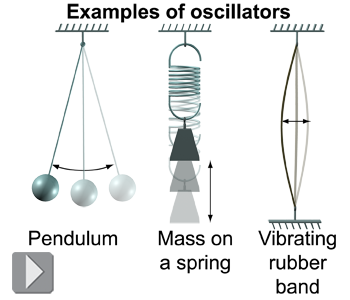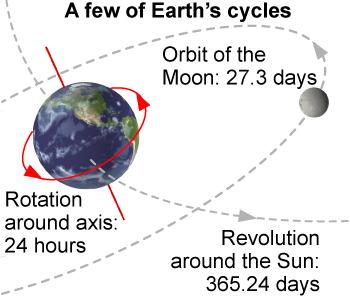|
As we look at moving things, we see two classes of motion. Linear motion goes from point to point without repetition. The concepts of Chapter 2, such as velocity and acceleration, arise from thinking about linear motion. This chapter deals with harmonic motion, which is motion that repeats over and over in identical patterns called cycles. A pendulum swinging back and forth is an example of harmonic motion. While the familiar concepts of position, velocity, and acceleration still apply, there are also new concepts that are unique to harmonic motion: frequency, period, amplitude, and resonance. 
|
Cycles and oscillators
|
The cycle is the building block of harmonic motion. A cycle is a unit of motion that repeats over and over. All harmonic motion is a repeated sequence of cycles. The cycles of three common examples of harmonic motion are shown in the figure at right. 
| 
|
A system in harmonic motion is called an oscillator. Examples of oscillators you might find in your physics lab include a pendulum, a mass hanging from a spring, and a vibrating rubber band. 
|
If you have a pendulum with a cycle one second long, you can count time in seconds by counting cycles of the pendulum. Counting cycles of an oscillator is the basis for nearly all clocks. Modern quartz watches and atomic clocks also count cycles, and the latter do so to an accuracy of better than 1 s in every 1,400,000 years! 
|
 An orbit and a rotation are both cycles because they are repeating motions. Both are the basis for calendars. The Earth–Sun system has an orbital cycle of one year. The Earth–Moon system has a orbital cycle of approximately one month. Earth itself has several cycles. Earth rotates on its axis once a day, creating the 24-hour cycle of day and night. There is also a wobble of the Earth’s axis, moving the orientation of the North and South Poles around by hundreds of miles every 22,000 years. There are cycles in weather, such as El Niño and La Niña oscillations in ocean currents, that produce fierce storms approximately every decade. Much of our planet’s ecology depends on cycles.
An orbit and a rotation are both cycles because they are repeating motions. Both are the basis for calendars. The Earth–Sun system has an orbital cycle of one year. The Earth–Moon system has a orbital cycle of approximately one month. Earth itself has several cycles. Earth rotates on its axis once a day, creating the 24-hour cycle of day and night. There is also a wobble of the Earth’s axis, moving the orientation of the North and South Poles around by hundreds of miles every 22,000 years. There are cycles in weather, such as El Niño and La Niña oscillations in ocean currents, that produce fierce storms approximately every decade. Much of our planet’s ecology depends on cycles. 
|
Which of the following is not an example of harmonic motion? - the motion of a mass on a spring
- the motion of a car on the highway
- the motion of the wheels on a bus
- the motion of a plucked guitar string
 |
The correct answer is b, the motion of a car moving along the highway. This motion is linear motion, as it does not repeat in a cycle. The other examples repeat in regular cycles, as is characteristic of harmonic motion. 
|
| |
|

